
The Rubiaceae are a family of flowering plants, commonly known as the coffee, madder, or bedstraw family. It consists of terrestrial trees, shrubs, lianas, or herbs that are recognizable by simple, opposite leaves with interpetiolar stipules and sympetalous actinomorphic flowers. The family contains about 13,500 species in about 620 genera, which makes it the fourth-largest angiosperm family. Rubiaceae has a cosmopolitan distribution; however, the largest species diversity is concentrated in the tropics and subtropics. Economically important genera include Coffea, the source of coffee, Cinchona, the source of the antimalarial alkaloid quinine, some dye plants, and ornamental cultivars.

Uncaria is a genus of flowering plants in the family Rubiaceae. It has about 40 species. Their distribution is pantropical, with most species native to tropical Asia, three from Africa and the Mediterranean and two from the neotropics. They are known colloquially as gambier, cat's claw or uña de gato. The latter two names are shared with several other plants. The type species for the genus is Uncaria guianensis.
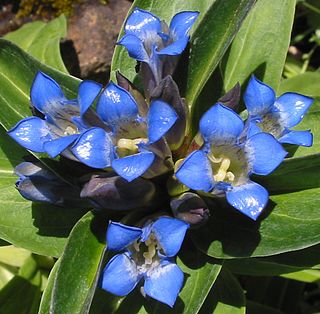
Gentianales is an order of flowering plants, included within the asterid clade of eudicots. It comprises more than 20,000 species in about 1,200 genera in 5 families. More than 80% of the species in this order belong to the family Rubiaceae.

Genipa is a genus of trees in the family Rubiaceae. This genus is native to the American tropical forests.

Galium is a large genus of annual and perennial herbaceous plants in the family Rubiaceae, occurring in the temperate zones of both the Northern and Southern Hemispheres. Some species are informally known as bedstraw.

Morinda is a genus of flowering plants in the madder family, Rubiaceae. The generic name is derived from the Latin words morus "mulberry", from the appearance of the fruits, and indica, meaning "of India".

Psychotria is a genus of flowering plants in the family Rubiaceae. It contains 1,582 species and is therefore one of the largest genera of flowering plants. The genus has a pantropical distribution and members of the genus are small understorey trees in tropical forests. Some species are endangered or facing extinction due to deforestation, especially species of central Africa and the Pacific.
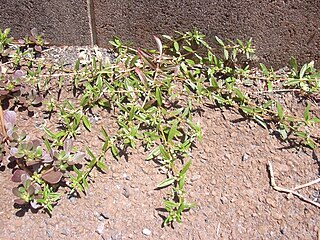
Oldenlandia is a genus of flowering plants in the family Rubiaceae. It is pantropical in distribution and has about 240 species. The type species for the genus is Oldenlandia corymbosa.

Alberta is a monotypic genus of flowering plants in the family Rubiaceae. Most species have been transferred to the genus Razafimandimbisonia, except for the type species Alberta magna. It is native to KwaZulu-Natal, South Africa and is commonly known as Natal flame bush.

Canthium is a genus of flowering plants in the family Rubiaceae. They are shrubs and small trees. The leaves are deciduous and the stems are usually thorny.

Gaertnera is a genus of flowering plants in the family Rubiaceae. There are at least 85 species distributed across the Old World tropics from Africa to Asia.

Palicourea is a plant genus in the family Rubiaceae. It contains about 200 species, which range from shrubs to small trees, and is distributed throughout the New World tropics.
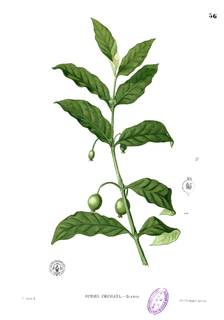
Randia, commonly known as indigoberry, is a mostly Neotropical genus of shrubs or small trees in the Rubiaceae. As of February 2022 Plants of the World Online lists a total of 112 accepted species in the genus. Several Australian species have been reassigned to the genus Atractocarpus. These include the garden plants Atractocarpus chartaceus and A. fitzalanii.

Vanguerieae is a tribe of flowering plants in the family Rubiaceae and contains about 655 species in 30 genera. It is one of the most species-rich groups within the family and it is distributed all over the Paleotropics.
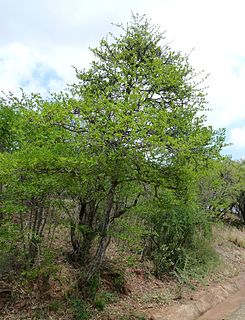
Afrocanthium is a genus of flowering plants in the family Rubiaceae. It consists of deciduous, unarmed trees, and shrubs. They are native to East Africa, from Sudan and Ethiopia to South Africa.

Hedyotis (starviolet) is a genus of flowering plants in the family Rubiaceae. Many species of this genus such as Hedyotis biflora, H. corymbosa and H. diffusa are well known medicinal plants. Hedyotis is native to tropical and subtropical Asia and to islands of the northwest Pacific. It comprises about 115 species. The type species for the genus is Hedyotis fruticosa.

Plocama is a genus of flowering plants in the family Rubiaceae. It was described by William Aiton in 1789. It is distributed from the Canary Islands to northwestern India.
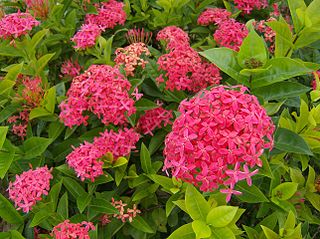
Ixoroideae is a subfamily of flowering plants in the family Rubiaceae and contains about 4000 species in 27 tribes.

Dr. Charlotte M. Taylor is a botanist and professor specialising in taxonomy and conservation. She works with the large plant family Rubiaceae, particularly found in the American tropics and in the tribes Palicoureeae and Psychotrieae. This plant family is an economically important group, as it includes plant species used to make coffee and quinine. Taylor also conducts work related to the floristics of Rubiaceae and morphological radiations of the group. Taylor has collected plant samples from many countries across the globe, including Chile, Colombia, Costa Rica, Panama, and the United States of America, and has named many new species known to science from these regions. As of 2015, Taylor has authored 278 land plant species' names, the seventh-highest number of such names authored by any female scientist.
Herbert Fuller Wernham was a British botanist, who from 1909 to 1929 worked at the British Museum, as an assistant in the Botany department. From 1911 to 1921 he published extensively on tropical plants and many genera, retiring in 1921 due to ill health (alcoholism).


















